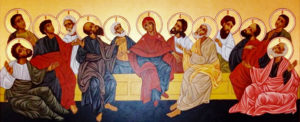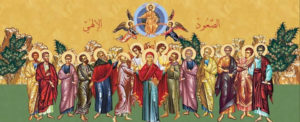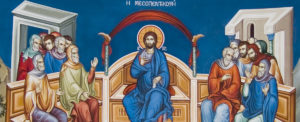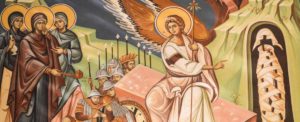The pagan Roman emperors tried to completely eradicate from human memory the holy places where our Lord Jesus Christ suffered and was resurrected for mankind. The emperor Hadrian (117-138) gave orders to cover over the ground of Golgotha and the tomb of the Lord, and to build a temple of the pagan goddess Venus and a statue of Jupiter.
Pagans gathered at this place and offered sacrifice to idols there. Eventually after 300 years, by divine providence, the great Christian sacred remains, the tomb of the Lord and the life-creating Cross were again discovered and opened for veneration. This took place under the Emperor Constantine (306-337).
In 313 he had issued the Edict of Milan, by which the Christian religion was legalized and the persecutions against Christians in the Western half of the empire were stopped. The ruler Licinius, although he had signed the Edict of Milan to oblige Constantine, still fanatically continued the persecutions against Christians. Only after Constantine conclusively defeated him did the 313 Edict of toleration extend also to the Eastern part of the empire. The emperor Constantine, having gained victory over his enemies in three wars with God’s assistance, had seen in the heavens the sign of the Cross, and written beneath: “By this sign you shall conquer.”
Ardently desiring to find the Cross on which our Lord Jesus Christ was crucified, Saint Constantine sent his mother, the pious empress Helen (May 21), to Jerusalem, providing her with a letter to Saint Macarius, Patriarch of Jerusalem.
Although the holy empress Helen was already in her declining years, she set about completing the task with enthusiasm. The empress gave orders to destroy the pagan temple and the statues in Jerusalem. Searching for the life-giving Cross, she made inquiry of Christians and Jews, but for a long time her search remained unsuccessful.
Finally, they directed her to a certain elderly Hebrew by the name of Jude who stated that the Cross was buried where the temple of Venus stood. They demolished the pagan temple and, after praying, they began to excavate the ground. Soon the empty tomb of the Lord was uncovered. Not far from it were three crosses, a board with the inscription ordered by Pilate, and four nails which had pierced the Lord’s body.
In order to discern on which of the three crosses the Savior was crucified, Patriarch Macarius alternately touched the crosses to a corpse. When the Cross of the Lord touched the dead one, he came to life. Having beheld the raising of the dead man, everyone was convinced that the life-giving Cross was found.
Christians came in a huge throng to venerate the holy Cross, beseeching St Macarius to elevate the Cross, so that even those far off might look on it with reverence. Then the Patriarch and other spiritual leaders raised up the Holy Cross, and the people, saying “Lord have mercy,” reverently prostrated before the wood of the venerable Cross of Christ. This solemn event occurred in the year 326.
During the discovery of the life-giving Cross another miracle took place: a grievously sick woman, beneath the shadow of the holy Cross, was healed instantly. The elder Jude and other Jews there believed in Christ and accepted holy baptism. Jude received the name Kyriakos and afterwards was consecrated Bishop of Jerusalem.
During the reign of Julian the Apostate (361-363) he accepted a martyr’s death for Christ. The holy empress Helen journeyed to the holy places connected with the earthly life of the Savior, building more than 80 churches, at Bethlehem the birthplace of Christ, and on the Mount of Olives where the Lord ascended to the heavens, and at Gethsemane where the Savior prayed before His sufferings and where the mother of God was buried after her death.
Saint Helen took part of the life-giving wood and nails with her to Constantinople. The holy emperor Constantine gave orders to build at Jerusalem a majestic and spacious church in honor of the Resurrection of Christ, also including under its roof the life-giving tomb of the Lord and Golgotha. The temple was constructed in about ten years. St Helen did not survive until the dedication of the temple, she died in the year 327. The church was consecrated on September 13, 335. On the following day, September 14, the festal celebration of the Exaltation of the Venerable and Life-Giving Cross was established.
Another event connected to the Cross of the Lord is remembered also on this day: its return to Jerusalem from Persia after a fourteen year captivity. During the reign of the Roman emperor Phocas (602-610) the Persian emperor Khosrau II defeated the Roman army, plundered Jerusalem and captured both the life-giving Cross of the Lord and the holy Patriarch Zachariah (609-633).
The Cross remained in Persia for fourteen years and only under the emperor Heraclius (610-641), who with the help of God defeated Khosrau and concluded peace with his successor and son Kavadh II, was the Cross of the Lord returned to the Christians.
With great solemnity the life-giving Cross was transferred to Jerusalem. Emperor Heraclius in imperial crown and royal purple carried the Cross of Christ into the temple of the Resurrection. With the emperor went Patriarch Zacharias. At the gates by which they ascended Golgotha, the emperor suddenly stopped and was not able to proceed farther. The holy Patriarch explained to the emperor that an angel of the Lord was blocking his way. The emperor was told to remove his royal trappings and to walk barefoot, since He Who bore the Cross for the salvation of the world from sin had made His way to Golgotha in all humility. Then Heraclius put on plain clothes, and without further hindrance carried the Cross of Christ into the church.
The Church commemorates the elevation of the precious and life-giving Cross of the Lord annually on September 14.
Troparion: O Lord, save thy people and bless thine inheritance; grant victory to the faithful over their enemies and preserve thy habitation by Thy Cross.
Kontakion: As thou wast voluntarily crucified for our sake, grant mercy to those who are called by thy name; make all Orthodox Christians glad by thy power, granting them victory over their adversaries, by bestowing on them the invincible trophy, thy weapon of peace!






